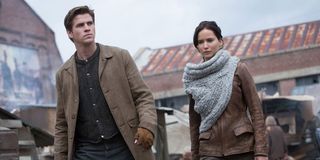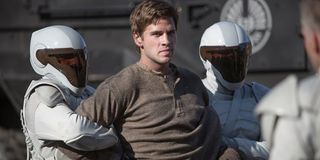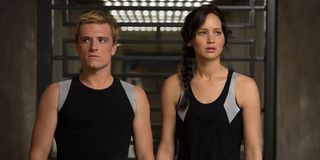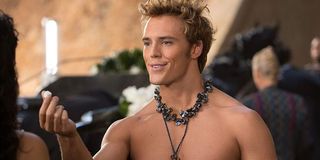Eight Big Differences Between The Hunger Games: Catching Fire Book And Movie

With a brand new director and a much bigger budget to support The Hunger Games: Catching Fire, fans of the franchise hoped that the second movie could capably manage to recreate the vivid scenes of revolting populations, The Capitol’s excess, and above all the magnitude of the arena imagined in Suzanne Collins’ popular Young Adult novel. As Collins’ vision of her heroine Katniss Everdeen grows and expands, so does her vision of the world Katniss inhabits. It was a tall order for director Francis Lawrence to bring the more sprawling Catching Fire book to the big screen, but mostly he manages to retain the heart of the book and many of its key moments, while trimming off some of the fat.
Since the books are all told from Katniss’ perspective, many of the big changes are made so that ideas can be spelled out for viewers since they can’t be accessed stream of conscious-style from her mind. In other instances, changes are made from the film to the books presumably to help narrow the film’s runtime somewhat and to cut out excess characters and tropes. The movie seamlessly blends some of the best dialogue, plots, and imagery from the books while retaining some of the filming tactics employed during the first effort. To Lawrence’s credit, this largely works.
Following are the eight biggest changes I noticed in my screening of The Hunger Games: Catching Fire. Plenty of other details were changed, of course, and feel free to remark on any changes you feel may have been more noticeable. There are many spoilers in The Hunger Games: Catching Fire book to movie comparison. Do not delve in if you want the film to be a surprise.

There is less of a strain between Katniss and those who love her. The movie begins with a scene featuring Katniss and Gale hunting, rather than Katniss hunting alone and pining for the moments she used to spend with Gale before he began to shun her and her gifts from The Capitol. Additionally, while Katniss and Peeta are frosty toward one another early on, they work things out fairly quickly.

We spend less time with Katniss in District 12. There’s a full year between Katniss’ first set of games and the Quarter Quell, and in the book, we get to spend many long months with Katniss before she ever gets near the arena. The set-up is actually quite long in the movie, but we don’t get to see the slow build-up of the peacekeepers setting up their rules, we don’t get to see the electric fence turned back on in District 12, and we don’t get to see Katniss and Peeta training like Careers.

The resistance is kept more under wraps. While Katniss sees snippets of rebellion on the train, as well as Gale’s beating, she never runs into District 8 refugees Bonnie and Twill and she doesn’t have to deal with Gale’s friend Darius getting turned into a tongue-less Avox after defying the District 12 peacekeepers. These details keep her from learning as much about the resistance as she knows in the books. While she senses a revolution brewing, she is also more sheltered from it.

Haymitch’s backstory is never made clear. In the books, we know that Haymitch actually won the previous Quarter Quell, and Peeta and Katniss make it a point to watch and see how their mentor was able to overcome obstacles and win the heightened version of the Hunger Games only after his District 12 partner—a character who plays a similar role to Rue—is tragically killed by an obstacle in the arena. This helps to flesh out Haymitch beyond the amusing and clever but drunken mentor he plays through the first two films.
CINEMABLEND NEWSLETTER
Your Daily Blend of Entertainment News

Caesar Flickerman also plays a key role in setting up The Capitol’s excess and the large dichotomy between the glamour and the bloodlust in the games. While Flickerman has a small but key role in the books, the film uses the character as a device to give news updates and make the games seem much more like a sporting event.

Like the first film in the franchise, we get to see more from Snow and his behind-the-scenes ideas and machinations. In the books, we get to see Snow through the eyes of Katniss and how she perceives his mind to work, but in the movies, things are spelled out a little more clearly via scenes featuring Snow and the new Head Gamemaker, Plutarch Heavensby.

The importance of bread never makes an appearance in the movie. Katniss never gets to witness the mockingjay bread that Bonnie and Twill use as a claim to resistance. Additionally, bread in the arena is important, signaling the time and date that Betee and the gang should try to trigger the wire coil to electrocute the stadium and make a grand escape. The bread is a minor plot device, but including it would have helped to explain why the escape plan was executed only at that time.

Katniss thinks about attacking Finnick rather than the frightening Enobaria toward the end of the film. Placing Finnick in the path of Katniss’ arrows heightens the stakes a little bit, and when he repeats the words that Haymitch told Katniss about remembering the real enemy, we know once and for all that he is on her side and that plans in the arena have never been quite what they seem.

Jessica Rawden is Managing Editor at CinemaBlend. She’s been kicking out news stories since 2007 and joined the full-time staff in 2014. She oversees news content, hiring and training for the site, and her areas of expertise include theme parks, rom-coms, Hallmark (particularly Christmas movie season), reality TV, celebrity interviews and primetime. She loves a good animated movie. Jessica has a Masters in Library Science degree from Indiana University, and used to be found behind a reference desk most definitely not shushing people. She now uses those skills in researching and tracking down information in very different ways.
Most Popular






